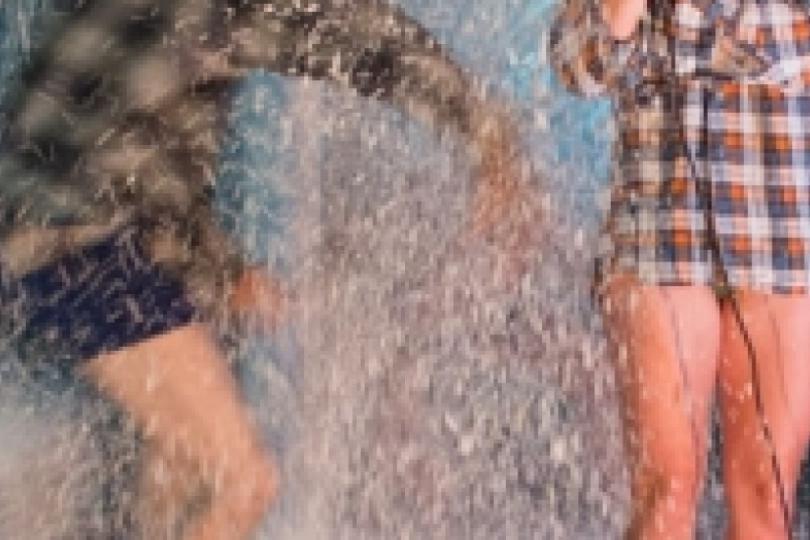Best of 2011-2012
Editorial

Editor's note: This is the first in a series of personal essays from local artists about the best of the 2011-2012 season.
Since I was asked to write about my favorite performance of the last season I’ve done a great deal of contemplating about what attracts me to a performance in the first place. What constitutes great theater? I’ve chosen two pieces - Jon Ferguson’s A Bun For A Door Handle and Samantha Johns’ and George McConnell’s Snowfuck--that equally embody the virtues of a truly satisfying theater experience for me.
Neither of these productions took place in traditional theater spaces; they were not script-based but ensemble-created collages of movement and text; and, ultimately, these productions side-lined story as the focus or, in Snowfuck’s case, did away with story altogether. This allowed me to bring my own experience and freed me from the expectations traditional theater often offers. Why does sitting on the floor of an abandoned warehouse make for a richer theatrical experience than, say, sitting in a button-down shirt at the Guthrie?
Strutting and Fretting
The theater space is a church to me; I worship images, conversations, and the physical and mental motions of performance like many worship Jesus. It’s where I found voice and acceptance in high school. Hell, I even got married in a theater. However, theater spaces can cause problems for the work they house and present. Comfort with traditional theater spaces and their accompanying devices—like the separation of audience and performer via curtains or the separation of space and reality via blackouts—prescribe a certain kind of behavior and experience. We know what to expect when we enter the space: the ushers tear our tickets, the lights dim as the play starts, the curtain opens up, etc. We are viewing the work from a place of reclined comfort. I find that this distances me from what I’m watching, and I become more of a passive onlooker with little stake in the actions within the space.
Bun and Snowfuck were more immersive due partly to the fact that they did not take place in conventional spaces; rather they were staged in abandoned spaces—an unfinished interior of a furniture store and the empty second floor of a Halloween store, respectively. Bun’s space was stark. The floor’s concrete was coarse and dusty. Bare light bulbs hung above the playing space, which was sandwiched between rows of audience chairs. The chairs on the right faced the chairs looking on from the left. Already we are seeing the audience as much a part of the mise-en-scène as the unpainted 1x4 rectangular window that frames a trio of idyllic flowers (that look like something out of Super Mario 2). The floor of the playing space is haphazardly covered with puzzled-together sheets of plywood.
Likewise, Snowfuck was staged in an large, uninterrupted wood-floored second floor space. Semi-translucent walls of plastic hung from the ceiling to floor effectively shrinking the capacious retail space into an intimate horizontal rectangle. Kernels of Styrofoam, the "snow," covered the surface of the floor, acting as an inanimate bouncer between the entrance to the playing space and the lobby area where audience members were encouraged to fill styrofoam coffee cups (which also acted as tickets) with ice from a large aluminum bathtub. When it was time for us to make our way to sit down, Johns shoveled a pathway from lobby to the space where the performance was already underway.
Both of these pieces, while not necessarily related to the specifics of their site, benefitted greatly from their environments. The spaces echoed the rough-edged style of the work that was presented within them. We audience members had far fewer of the standard referents in these non-traditional spaces than we would have in the steep rake of the Rarig Thrust or even the cozy neighborly slumber of Open Eye Figure Theater. The lack of these traditional referents allowed me to watch the work with less presumption and the work, therefore, was more unpredictable because there was little or no separation between the performer’s space and my space. This type of immersion effectively deputized its audience as an active participant.
Samantha Johns and George McConnell and their fellow snowfuckers ask: how do we keep ourselves warm and our bodies and minds active in the heart of winter? The ever-present strain of restlessness that seems to fuel the piece and its players fuels the opening image: we see the entire ensemble bundled up with layer upon layer of clothing—so bundled that they, much like Ralphie’s little brother from A Christmas Story, are barely able to move, speak, or physically engage with anybody outside of their cloth/hives. Orange and pink gelled clip lamps make up our entire source of light causing a dim, opium-lounge vibe that makes you want to kick your shoes off and stay a while.
“Snowfuck isn’t about anything, but is something,” reads a blurb on Bedlam Theatre’s website recommending the show. As opaque as that blurb is I think it’s really fitting to the piece. This is not to say Samantha Johns, George McConnell and company are feckless in the work they have mounted. Quite the contrary. Their skill and precision at creating captivating images and scenarios are up there with the brush strokes of Live Action Set’s Deviants. And "mounted" is an appropriate word because sexuality is at the center of Snowfuck’s imagining.
I love how quickly they move past the shock factor of onstage nudity. Instead of allowing it to become an ornamental and diluted abstracted performance arty thing, they righteously b-line directly into what the nudity conjures in our minds and loins: doing playful things with each others vaginas and asses. I spent an hour thoroughly engaged and delighted by this piece and, retrospectively, by how they pulled this off without a story in sight.
The transformation in this piece does not root itself in story so much as course through a hive-mind thought-feeling tunnel of exploration. What the hell am I talking about with ‘hive mind thought-feeling exploration’ is a great question but helps me arrive to my point: As a result of Snowfuck’s absence of story these ensemble members operate not so much as linear characters as they work as physical conduits of the intimacy and sexual imagery Johns and McConnell present us. When story isn’t the main thing, and we aren’t prescribed a context and character-based narrative structure—the same one that movies and plays have made us pros at recognizing and engaging with—we are given permission to interact with and comprehend the work in a less presumptive and more lucid way.
I love to see work that frees me from the expectations of traditional theater and allows me to engage with it through my own experiences, fully. It’s refreshing to navigate through a performance via a series of images rather than a story. Does a series of images hold up to other more accessible and story-based productions? I say yes because work like this has to work so much harder to win its audience; and when it does win us, it feels like a small miracle. I feel the urge to find someone and tell them about this miracle. Unfortunately, trying to describe this miracle is kind of like describing colors to the blind.
I keep trying to describe it and cram meaning, importance, and articulated significance into it, but that wouldn’t be the point. Instead, in the end, I choose to sit still, o’erswept by the images and moments. I sit still and stew.




